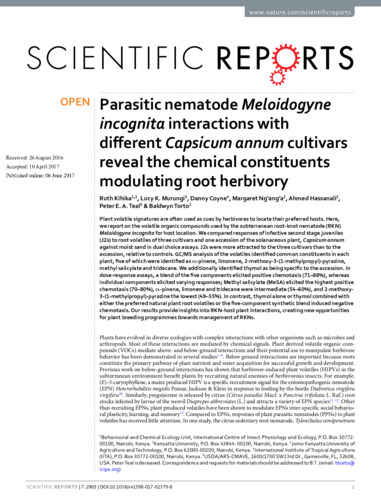Parasitic nematode Meloidogyne incognita interactions with different Capsicum annum cultivars reveal the chemical constituents modulating root herbivory
Abstract
Plant volatile signatures are often used as cues by herbivores to locate their preferred hosts. Here, we report on the volatile organic compounds used by the subterranean root-knot nematode (RKN) Meloidogyne incognita for host location. We compared responses of infective second stage juveniles (J2s) to root volatiles of three cultivars and one accession of the solanaceous plant, Capsicum annum against moist sand in dual choice assays. J2s were more attracted to the three cultivars than to the accession, relative to controls. GC/MS analysis of the volatiles identified common constituents in each plant, five of which were identified as α-pinene, limonene, 2-methoxy-3-(1-methylpropyl)-pyrazine, methyl salicylate and tridecane. We additionally identified thymol as being specific to the accession. In dose-response assays, a blend of the five components elicited positive chemotaxis (71–88%), whereas individual components elicited varying responses; Methyl salicylate (MeSA) elicited the highest positive chemotaxis (70–80%), α-pinene, limonene and tridecane were intermediate (54–60%), and 2-methoxy- 3-(1-methylpropyl)-pyrazine the lowest (49–55%). In contrast, thymol alone or thymol combined with either the preferred natural plant root volatiles or the five-component synthetic blend induced negative chemotaxis. Our results provide insights into RKN-host plant interactions, creating new opportunities for plant breeding programmes towards management of RKNs.

